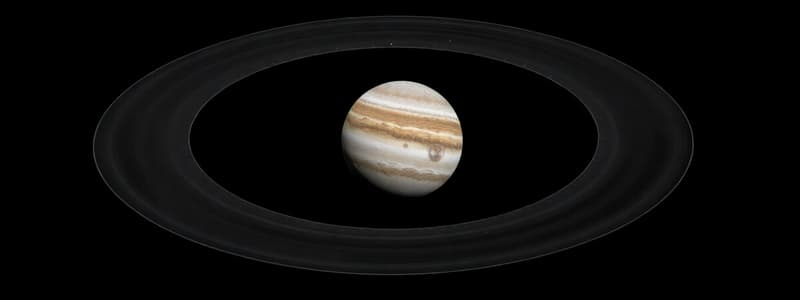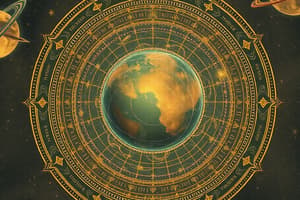Podcast
Questions and Answers
ما هو العامل الرئيسي الذي اعتمد عليه كبلر في اعتقاده بأن الشمس تولد قوة تؤثر على الكواكب؟
ما هو العامل الرئيسي الذي اعتمد عليه كبلر في اعتقاده بأن الشمس تولد قوة تؤثر على الكواكب؟
- حجم الكواكب
- تركيب الكواكب
- بعد الكواكب عن الأرض
- المشاهدات الفلكية الدقيقة لحركة الكواكب (correct)
ينص القانون الأول لكبلر على أن مدارات الكواكب إهليلجية، ماذا يمثل موقع الشمس في هذا المدار؟
ينص القانون الأول لكبلر على أن مدارات الكواكب إهليلجية، ماذا يمثل موقع الشمس في هذا المدار؟
- في نقطة تقاطع المحاور
- في مركز الدائرة
- على المحور الطويل
- في إحدى البؤرتين (correct)
ماذا يحدث لسرعة الكوكب في مداره حول الشمس وفقاً للقانون الثاني لكبلر؟
ماذا يحدث لسرعة الكوكب في مداره حول الشمس وفقاً للقانون الثاني لكبلر؟
- تزداد السرعة عندما يبتعد الكوكب عن الشمس
- تتغير السرعة بشكل عشوائي
- تزداد السرعة عندما يقترب الكوكب من الشمس (correct)
- تبقى السرعة ثابتة على طول المدار
إذا كان الزمن الدوري لكوكب حول الشمس ضعف الزمن الدوري لكوكب آخر، فما العلاقة بين متوسط بعديهما عن الشمس وفقاً للقانون الثالث لكبلر؟
إذا كان الزمن الدوري لكوكب حول الشمس ضعف الزمن الدوري لكوكب آخر، فما العلاقة بين متوسط بعديهما عن الشمس وفقاً للقانون الثالث لكبلر؟
أي العبارات التالية تصف بشكل صحيح طبيعة مدارات الكواكب والأقمار في نظامنا الشمسي؟
أي العبارات التالية تصف بشكل صحيح طبيعة مدارات الكواكب والأقمار في نظامنا الشمسي؟
بناءً على قانون نيوتن للجذب الكوني، كيف تتأثر قوة الجذب بين جسمين إذا تضاعفت كتلة أحد الجسمين؟
بناءً على قانون نيوتن للجذب الكوني، كيف تتأثر قوة الجذب بين جسمين إذا تضاعفت كتلة أحد الجسمين؟
وفقاً لقانون نيوتن للجذب الكوني، كيف تتأثر قوة الجذب بين جسمين إذا تضاعفت المسافة بين مركزيهما؟
وفقاً لقانون نيوتن للجذب الكوني، كيف تتأثر قوة الجذب بين جسمين إذا تضاعفت المسافة بين مركزيهما؟
ما الذي يمكن حسابه باستخدام قيمة ثابت الجذب الكوني G بالإضافة إلى نصف قطر الأرض وتسارع الجاذبية الأرضية؟
ما الذي يمكن حسابه باستخدام قيمة ثابت الجذب الكوني G بالإضافة إلى نصف قطر الأرض وتسارع الجاذبية الأرضية؟
ماذا يمثل المفهوم الذي استنتجه نيوتن بعد ملاحظة سقوط التفاحة وتعميمه ليشمل القمر والأجرام السماوية؟
ماذا يمثل المفهوم الذي استنتجه نيوتن بعد ملاحظة سقوط التفاحة وتعميمه ليشمل القمر والأجرام السماوية؟
ما هي أهمية تجربة كافندش في سياق فهمنا للجاذبية؟
ما هي أهمية تجربة كافندش في سياق فهمنا للجاذبية؟
Flashcards
القانون الأول لكبلر
القانون الأول لكبلر
مدارات الكواكب ليست دائرية تمامًا ولكنها بيضاوية الشكل، والشمس تقع في إحدى البؤرتين.
القانون الثاني لكبلر
القانون الثاني لكبلر
تتغير سرعة الكوكب في مداره؛ فهو يتحرك أسرع عندما يكون قريبًا من الشمس وأبطأ عندما يكون بعيدًا عنها. الخط الوهمي من الشمس إلى الكوكب يمسح مساحات متساوية في أزمنة متساوية..
القانون الثالث لكبلر
القانون الثالث لكبلر
مربع النسبة بين الزمنين الدوريين لكوكبين يساوي مكعب النسبة بين متوسط بعديهما عن الشمس.
قانون الجذب الكوني لنيوتن
قانون الجذب الكوني لنيوتن
Signup and view all the flashcards
تأثير المسافة في قوة الجذب
تأثير المسافة في قوة الجذب
Signup and view all the flashcards
ثابت الجذب الكوني
ثابت الجذب الكوني
Signup and view all the flashcards
صيغة قانون الجذب الكوني
صيغة قانون الجذب الكوني
Signup and view all the flashcards
ميزان كافنديش
ميزان كافنديش
Signup and view all the flashcards
Study Notes
- The text provides an overview of planetary motion, gravitation, and related concepts, experiments, and laws.
Initial Experiment
- The initial experiment explores whether planets in our solar system move in circular or other shaped orbits.
- One can create a model of Mercury's orbit to investigate this question.
- Use the data table to plot Mercury's orbit, using a scale of 1 cm = 1 AU.
- Recall 1 AU = 1.5 x 10^8 km.
- Calculate the distance in cm for each measured distance in AU.
- Mark a point at the center of your paper and draw the main axes x and y at this point.
- Put the protractor on the horizontal line, with its center coinciding with the paper's center.
- Then, measure the degrees and make a mark.
- Place the ruler so that it passes through the center and the angle mark, and mark the distance to the angle in centimeters.
- After placing all the data point marks, draw a line connecting them.
- Note the shape of Mercury's orbit, and draw a line through the sun that represents the longest axis of the orbit, labeling it the major axis.
Critical Thinking
- One could compare Mercury's orbit to that of Comet Hale-Bopp.
Planetary Motion and Gravitation
- Initially, it was believed that the sun, moon, planets, and stars all revolved around the Earth.
- Nicolaus Copernicus noted inconsistencies between observations of planetary and stellar motion with this Earth-centered model.
- Copernicus proposed that planetary motion could be better understood by assuming the Earth, along with other planets, orbits the sun.
- Tycho Brahe observed a solar eclipse in 1560 and subsequently dedicated his life to astronomy without a telescope, instead using instruments he designed himself.
- Brahe wrongly thought that the sun and moon revolved around the Earth while the other planets revolved around the sun.
Kepler's Laws
- Johannes Kepler, a German astronomer, became Brahe's assistant in Prague.
- Kepler inherited Brahe's observational data and dedicated himself to studying and analyzing it.
- Kepler believed the sun exerted a force on the surrounding planets, acting as the center of the solar system.
- After an in-depth analysis of the motion of Mars, he discovered the laws describing the motion of each planet.
- Kepler's first law states that the orbits of planets are elliptical with the sun at one focus.
- Comets, like planets and stars, also move in elliptical orbits, divided into two categories based on their orbital period.
- One group has orbital periods longer than 200 years, while the other group has periods shorter than 200 years.
- Comet Hale-Bopp has an orbital period of 2400 years, while Halley's Comet has a period of only 76 years.
- Planets orbit the sun in elliptical paths, with the sun at one of the foci.
Speed and Distance
- Kepler discovered that planets move faster when closer to the sun and slower when farther away.
- Kepler's second law states that a line from the sun to the planet sweeps out equal areas in equal times.
- Kepler's third law states that the square of the ratio of the periods of any two planets revolving around the sun is equal to the cube of the ratio of their average distances from the sun.
Kepler's Third Law Equation
- The third law is expressed as (T_A/T_B)^2 = (r_A/r_B)^3. ,
- The expression relates the orbital periods and average distances of two planets orbiting the sun.
- The first and second laws apply to each planet individually.
- The third law relates the motion of multiple planets around the same body.
- The third law is used to compare the distances of planets from the sun using their orbital periods, as shown in a data table.
- It is also used to compare the distances and periods of the moon and artificial satellites around the Earth.
- The orbits of planets around stars vary in their ellipticity.
- Some orbits are nearly circular, like that of Venus, and the orbits of moons around planets are also nearly circular.
- Here, planetary and lunar orbits are assumed to be circular to simplify calculations.
Data from Objects
- The table provides the mean radius, mass, and average distance from the sun for various celestial bodies.
- Calculating the fourth moon's distance: Given the periodic time of Jupiter's moons, Galileo measured the dimensions of their orbits using Jupiter's diameter as a unit of measure.
- He discovered that the periodic time of the nearest moon is 1.8 days, located at a distance of 4.2 units from Jupiter's center.
- The fourth moon, however, has a periodic time of 16.7 days. The distance of this moon from Jupiter had to be calculated.
- Then, the example shows how to analyze and solve the problem, find an unknown value, and evaluate the answer.
Newton's Law of universal Gravitation
- Newton began studying the motion of planets after Johannes Kepler published his results 45 years after 1666 AD.
- Newton found that the magnitude of the sun's gravitational force F acting on a planet is inversely proportional to the square of the distance squared, r, between the center of the planet and the center of the sun.
- The force F acts in the direction of the line connecting the centers of the two bodies.
- The apple's falling made Newton hypothesize whether gravity extends towards the moon or even further.
- According to Newton's third law, the force that the Earth exerts on an apple is equal to the force that the apple exerts on the Earth.
- The force of attraction between any two bodies must be proportional to the masses of these bodies.
- Newton formulated his law of universal gravitation, that objects attract other objects with a force proportional to the product of their masses and inversely proportional to the square of the distance between their centers.
Universal Gravitation Law
- Newton, using the formula F = G(m1m2/r^2) constant is multiplied by the mass of the first object multiplied by the mass of the second object divided by the square of the distance between the centers of the two objects.
- According to Newton's law, the force F is directly proportional to m1 and m2; therefore, if the mass of the planet near the sun is doubled, the force will double.
Relationships
- Various relationships influence an object's interaction in proportional and inversely proportional interactions.
Universal Gravitation and Kepler's Third Law
- Newton formulated the law of universal gravitation in terms applicable to the motion of planets around the sun.
- The force of gravity is F = G(mpms/r^2), where mp and ms are the masses of the planet and sun, respectively.
- The period T is given by T = sqrt((4p^2r^3)/(Gms)).
Measuring the Universal Gravitational Constant
- The magnitude of the universal gravitational constant G? The attraction force between two objects on Earth is relatively weak.
- The force is difficult to detect between the masses of two bowling balls, for example.
- In fact, it took 100 years after Newton for scientists to design a sensitive device to measure the force of gravity.
Cavendish
- Henry Cavendish used the device in 1798 AD to measure the gravitational force between two bodies.
- The device has a horizontal arm with lead balls at its ends.
- The arm is suspended from its midpoint by a thin, rotatable wire.
- Because the arm is suspended by a thin wire, it is sensitive to any horizontal force.
- Cavendish measured the gravitational force between the masses by measuring the torque for different masses.
Studying That Suits You
Use AI to generate personalized quizzes and flashcards to suit your learning preferences.



